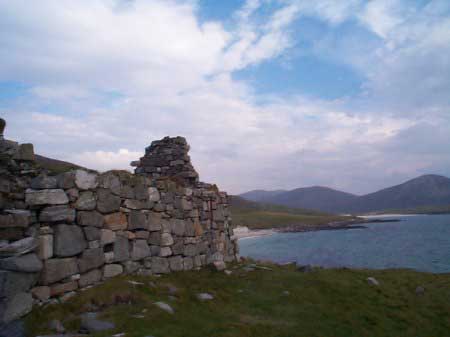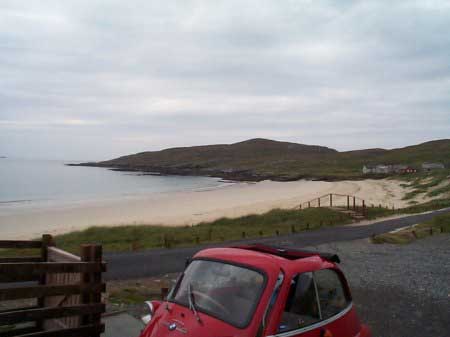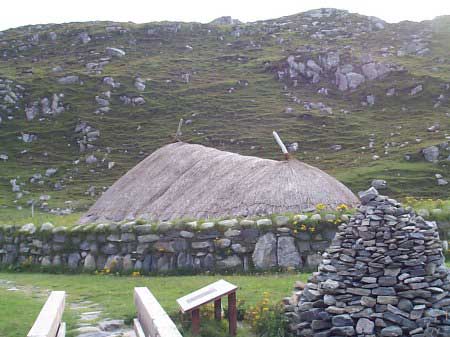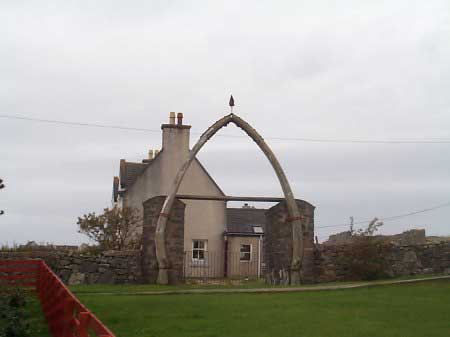In the Wheeltracks of Soapy...... And beyond!
Introduction
In 1978, Manchester IOC members Neil and Diane Ackerley took their Isetta 300 3 wheeler (called 'Soapy') from Manchester to the Isle of Skye for a driving holiday. Twenty two years later, Richard & Brenda Jones retraced their route to Skye, and then carried on over to the Western Isles of Lewis & Harris for a driving holiday of 10 days and over 1,700 miles.
In a day where the average motorist uses his car to get from 'A to B' and vintage/veteran cars cost so much more to restore that their owners are reluctant to take them more than 30 miles from home, you can read about their remarkable holiday here.
Starting Off
DAY ONE
It was a dark and miserable morning at 9am when we set off, and, in fact, the valley in which we live in was filled with fog. Luckily, this dissipated as we climbed out of the valley, and we were greeted by a glorious sunshine which followed us most of the way. The milage, at the start of the holiday, reads 9669.
Our route was up the A65 to Kendal (where we passed former member Gordon Fitzgeralds barber shop) and on to the A6. Lumbering up Shap (A steep hill between Kendal and Carlisle) brought the average mph down considerably. We also met Michael, from Carlisle, a fellow member who owns a left hand drive 3 wheeler. He couldn't believe his eyes when he saw an isetta, proceeding under its own power, along a road. So, of course, we spent a happy twenty minutes parked alongside the road while we went through the ," that's where that goes" routine. However, by 2pm, we were stopping for our lunch in the vicinity of Gretna Green. Home made cornish pasties had never been devoured in such a lovely surround. We had passed Carlisle, in the A6, and joined the A74 by the time we had stopped..
One of the most important things that we had treated ourselves to as an add on to the car was a battery powered kettle, operating off of the battery via two large crockodile clips. Ok, it took half an hour to boil the water, so we would put it on half an hour before we planned to stop, drive until it was boiling, and then pull off of the road for a cup of tea and a bun.
Our route then continued along the A74, then on to the A75, the A76 and finally the A77. We crossed the Clyde via the Eriskine bridge (toll for bubblecars 60p, even for those towing trailers) and we joined our last road for the night, the A82. At the bottom of Loch Lomond we stayed at a B&B in a village called Balloch, arriving at 7pm. Milometer reading 9904. Mileage to date 235. Average mph over the day 30. 50mpg.

Day 2 saw us back on the road after a good breakfast. We carried on up the A82, past Fort William, to Invergarry, and then turned left onto the A87 towards the Isle of Skye. The A87 (Invergarry to Uig trunk road) is extremely long and it wasn't until 2:30 in the afternoon that we happened across an inn by the side of the road where we could get refreshments. Thus refreshed we carried on to the Skye bridge (charged us £2.90 for a motorbike) and we were over the bridge and onto Skye itself. Just after we turned towards Uig we spied a cafe by the side of the road, and stopped for a proper meal.


We arrived at Uig around 5:30pm, and stayed at the wonderfully named Woodbine House. This B&B is literally only a minute away from the ferry terminal. Supper, that night, was taken at the aptly named 'Pub on the Pier' (It's a pub, and it's on a pier!). Milometer reading 10159. Milage today was 255. Average speed 34mph. 50mpg.

Day 3 saw us up bright and early, breakfasted, and joining the queue for the ferry. Now the arrival of the ferry is a sight to behold, because it screams in at about 10 knots, does a tight handbrake turn, reverses up to the ramp, and if you are not quick enough you'll miss it, because it only takes 10 minutes to load up and start away.

The crossing itself takes one hour and forty minutes, and the ferry terminal is at Tarbert, the capital of Harris. The cottage that we had rented was only £150.00 for the week, and was five miles away, towards the Isle of Scalpay. By 2pm we had arrived, unloaded, dropped off the trailer, and were ready to do some serious exploring. The holiday proper had started.
The pace of life on Harris / Lewis is like nothing you have ever experienced before. It is like a breath of fresh air after the hustle and bustle of day to day life. The air is so fresh and tangy, whilst the roads (mostly single track) are mostly empty. although called Harris & Lewis, the two Islands are actually one, joined together at a mountain pass. I'm sure it has a proper name, but Brenda and I named it 'pass not pass' as it actively discourages little cars from getting to Lewis. Harris has two roads on it. The first one, the main one, (the A859) goes straight through a lunar landscape of mountains and peat bogs, past Luskentyre beach and Northton, before ending at Rodel. The other road branches off left from the first road, and then visits all the rocky villages along Harris's east coast, before joining the other road again at Rodel. This second road is known simply as 'The Golden Road'. When it was built at the end of the 19th Century, it was said to have cost so much that people in London thought that it must have been made from gold! At many places you can see where peat has been cut. Peat is the primary fuel in the islands. It takes 60 years for one centimetre of peat to form, and, after cutting, it takes two months for it to dry out.

RODEL
Rodel was the old capital of Harris until Tarbert was established in 1779. Since then it has been in decline. One of the must see sights in Rodel is the beautifully restored church of St. Clements. St . Clements is no longer used as a church, and is best known for its three tombs. The dominant one is for Alexander Macleod, who had it built 19 years before his death. Due to a battle axe wound to his back, Alexander Macleod walked with a stoop, and was known as the hunchback. The church is very beautiful, and a very peaceful place to be.


The key to the church is left chained to the door, so that even if it is locked, one can always gain entry.

The saturday afternoon saw us drive along both roads on Harris, visiting Rodel and Northton briefly, before returning to the cottage for our tea and a settle down in front of the television. Milometer reading 10491.
DAY 4
Day 4 saw us up and about to another beautiful day. The sun was shining, and the sea was like a mirror at the front of the cottage.

This was late September, remember, so we were extremely pleased to have found an 'indian summer' in place over the islands.
It was sunday, so we knew that there would be nowhere open. We aimed to drive back down the A859 to Northton, and then walk to the island. It is joined by a causeway of grass covered sand dunes. We parked at the MacGillivray Centre in Northton. This centre, on several of our trips around Harris, proved to be a very useful stop indeed (if you know what I mean). The walk to Northton Island is about a mile and a half, and we visited the ancient 'team-

While we were at the ancient building we spotted three seals in the sea nearby, bobbing up and down, looking at us. They quickly got called 'The three Amigo's', and they sure were curious, if a little wary. The walk through the sand dunes on the shore of Northton Island is very nice, and I can highly recommend it.
By the time we got back to the car it was beginning to get dark, so we visited the MacGillivray centre again (ahem!) and then it was back to the cottage for another night in. Milometer reading 10247.

DAY 5
We travelled up the B887 towards Lewis, but before the quarry we turned off towards Hushinish Bay. At the junction is the old whaling station of Bunavondear. This was owned by Lord Leverhulme, who had bought it so that he could turn whales into sausages to feed the starving of Africa. Over ambitious, it failed, and its remains are still on the foreshore. Don't look to visit it. The land it is on is private, there is no access, and no parking, not even for an Isetta!

As you drive on along, you pass the only tennis court on Harris, which was built in 1998. It cost £62,000, and it took 2,000 tons of basalt to level the ground. Still, what a view.
As you continue along the road you pass Amhuinnsuiddhe castle (pronounced 'Avin Suey' Castle). The road goes right past their front door! It is owned by the Bulmer family (of Cider fame), and again, there is no stopping, but we snook a picture from the gatehouse.

The roads, as you can see from the next picture, are very narrow, but just perfect for our mode of transport!

At the end of the road is Hushinish bay, and quite one of the most beautiful beaches you will ever hope to see. The sand is so white, and the only foot prints are those of birds. It was here that we saw an Oyster Catcher for the first time. They are quite big birds, really.

Passing along a little track between the sand dunes you come to the Isle of Scarp. It was here in 1932 that early rocket experiments were carried out, but not successfully. Scarp has now been abandoned, and no one lives there.
Returning to the main A859, we drove down to the village of Rhenigidale. Until recently there was no road to here, and the only methods of reaching the village were by trecking through a mountain pass, or by boat. There is a youth hostel here which, until recently, had a thatched roof.

Finally, we drove back past our cottage to the Island of Scalpay. A ferry used to take the 200 inhabitants of Scalpay to and fro, but it was replaced, in 1998, by a single track bridge. This was opened by Tony and Cherie Blair in that year. He was the first standing Prime Minister, I believe, to have visited the islands.

I was even able to indulge in my other hobby whilst on Scalpay, wreck spotting. I found two. The first one is the hulk of the coaster 'Ortetree', which was registered in London.

The second wreck is that of the 'Gulf Star'. She was wrecked off of Scalpay in 1995. She is sat on a rock, which is holding her up!

Finally, as the sun set, we headed back to sit in its dying embers and drink tea! Milometer reading 10319.
DAY 6
Day 6 saw us drive onto Lewis for the first time. We went up the A859, over 'pass not pass' and then left and down to Mealasta. It's a rocky beach at the end, with the slight remains of an ancient monastery, Although it is a nice gated road. Returning, we stumbled across some old WW2 concrete bunkers, and we realised that in the war, this west coast was quite heavily garrisoned and fortified. Most of it has been removed now, though.

Next, we headed north, across the 'Bridge over the Atlantic' to the Isle of Bernera, and then on to the Iron Age village at Bosta.

The village was lost for thousands of years, and buried under sand dunes. Then, in 1996, a violent storm moved the dunes, and the village reappeared. A replica house has been built, but it was locked when we visited. The uncanny thing is that the iron age house is at the beginning of a heritage that ended with the black houses in 1962. What's a black house? Well, I'll come to that in a little while.


We had been on main tank all day, but, after 152 miles we went on to reserve. As we had 'pass not pass' waiting for us, I tipped the spare gallon into the tank. During this drive we had seen three buzzards, the best of which was the one that was preening itself on a fence post by the side of the road.
Halfway up 'pass not pass' is a memorial to the 'land raiders' in 1874. A rough description would be that the crofters were being forcibly evicted from the land by the land owners who wanted to plant trees and introduce deer. They marched on the land owners house, to be faced by troops who read the riot act, and who arrested the ring leaders. It was through their protest, though, that they kept their crofts and farms. Later, this memorial (along with others) was constructed. A coping stone comes from each of the arrested ring leaders crofts. Milometer reading 10491.

DAY 7
Today sees our self styled 'middle tour' of Lewis. The Isle of Lewis is a complete contrast to Harris. Where Harris is mountainous, with moorland, bogs and lakes, then Lewis is flat, and boggy. Even its old name 'Leodhas' means 'boggy place'. Up over 'pass not pass' on the A859 we headed, left along the A858, and then we curve rightwards up the west coast. It is another long drive to get to our destination, but perhaps there would be more to see today.
Our first stop is the Cullinish standing stones. You will have all heard of Stonehenge. Well, after those stones, the Cullinish Standing Stones are the second most important standing stones in the British Isles. As one who has seen Stonehenge, I actually think that they are more spectacular than Stonehenge. There is not much known about them, although speculation is a word that is used a lot in this area, but they are very impressive.

After the Cullinish stones we visited Carloway Boch. Again, this is iron age, and I suppose a brief description would be a fortified homestead. A funny thought that crossed my mind was the description of the building, showing cattle being kept inside it during the winter. Then you see the actual building, and the door is only 4 feet high! Over 70 feet of wall remain in places, and, in its original form, it is said to have resembled a cooling tower!


The weather was beginning to close in now, and it was beginning to rain, (our first and only day of inclement weather). We decided to continue up the road until we got to the Butt of Lewis. En route we passed the famous jaw bone of a blue whale that was washed ashore in 1919.

We then called in at the village of Argol, to see Number 40, a restored 'Black House'.
Let me tell you about black houses. They were built of dry stone walls, and would last 100 years before needing to be rebuilt, although they had a thatched roof which was replaced annually. They had no windows, and no chimney! The peat fire burnt on a hearth stone right in the middle of the floor! It was said that the fire was the heart of the family, and so was never allowed to go out. There are ruined black houses all over the island. Number 40, Argol was lived in until 1962.


Finally, at the Butt of Lewis, the weather finally arrived with a vengeance. We stopped, mainly so that we could say that we had been, and then headed for home. Milometer reading 10647.

The lighthouse at the Butt of Lewis
DAY 8
Today was our last visit to the Isle of Lewis. Back over 'Pass not pass' towards Stornoway, and then onwards to 'The Bridge to Nowhere'. Lord Leverhulme wished to build an east coast road to go up to Ness (near the Butt of Lewis). His engineers said, "fine, we've worked out a route," but Lord Leverhulme disagreed and insisted that the road follow the coast, an impossible dream. The road goes 17 miles northwards, crosses the bridge to nowhere (Garry Bridge), and then peters out into heather and peat bogs. It is a beautiful bridge, though, sat there, in the middle of nowhere!

We then drove into Stornoway itself, parking in the harbour side carpark, and visiting the old Stornoway town hall, which now houses an exceedingly good cake and coffee shop. We also saw Lord Leverhulmes old home, Lews Castle.



Otherwise, we found Stornoway a typical town, shops, banks, harbour, busy, busy, busy. Milometer reading 10775
DAY 9
Our last day on the Western Isles. We decided to visit Harris again, looking around Rodel, and driving the 'golden road' again. We also visited Luskentyre beach, and it is probably the most beautiful stretch of sand that I have ever been on. It is breathtaking.
When we got to Rodel, we found a derelict hotel that we had missed the first time around. It is behind St Clements Church. although typical of many derelict buildings on the islands, it did have an interesting plaque on the wall. I bet it didn't look like that then. Milometer reading 10837.


DAY 10
Saw us back on our way home. We landed at Uig, on Skye, from the ferry at 12:40pm, and headed south, finally stopping at a B&B just outside Fort William. We then dropped off the trailer and went into Fort William itself for our treat, a slap up meal in a posh restaurant.
DAY 11
Our last day of the holiday. Setting off at 9am, we drove back from Fort William, down the A82, through Glasgow (2 hours before a Rangers game, phew!) and down to Gretna Green. By 5pm we were in the vicinity of Penrith. By that time, we were thinking that it was too close to home to be worth stopping another night, so we just kept on going, finally arriving home at 9:20pm, having done 360 miles in one go. Final milometer reading 11429.
LESSONS LEARNT
We took plenty of petrol with us, but, if you choose to retrace our steps, I would suggest that you only need one can of fuel. One thing that was worth its weight in gold was the kettle. Drink stops are few and far between. With the ability to put the kettle on every two hours, we were able to keep ourselves refreshed. Even on the last day's long drive, neither of us suffered from tiredness. The final tally in miles on holiday was 1,759. Not bad for a 298cc engine, two people, and a trailer full of luggage. We averaged 30mph over the holiday, and did 50mpg with the trailer on and 75 mpg with it off. We spent £116 on fuel and oil.
If you do plan a holiday, I would suggest that you visit the excellent web site for the islands. We used this site extensively for our planning.
There was so much to do, so much to see, and so much to visit. Eleven days were barely enough.